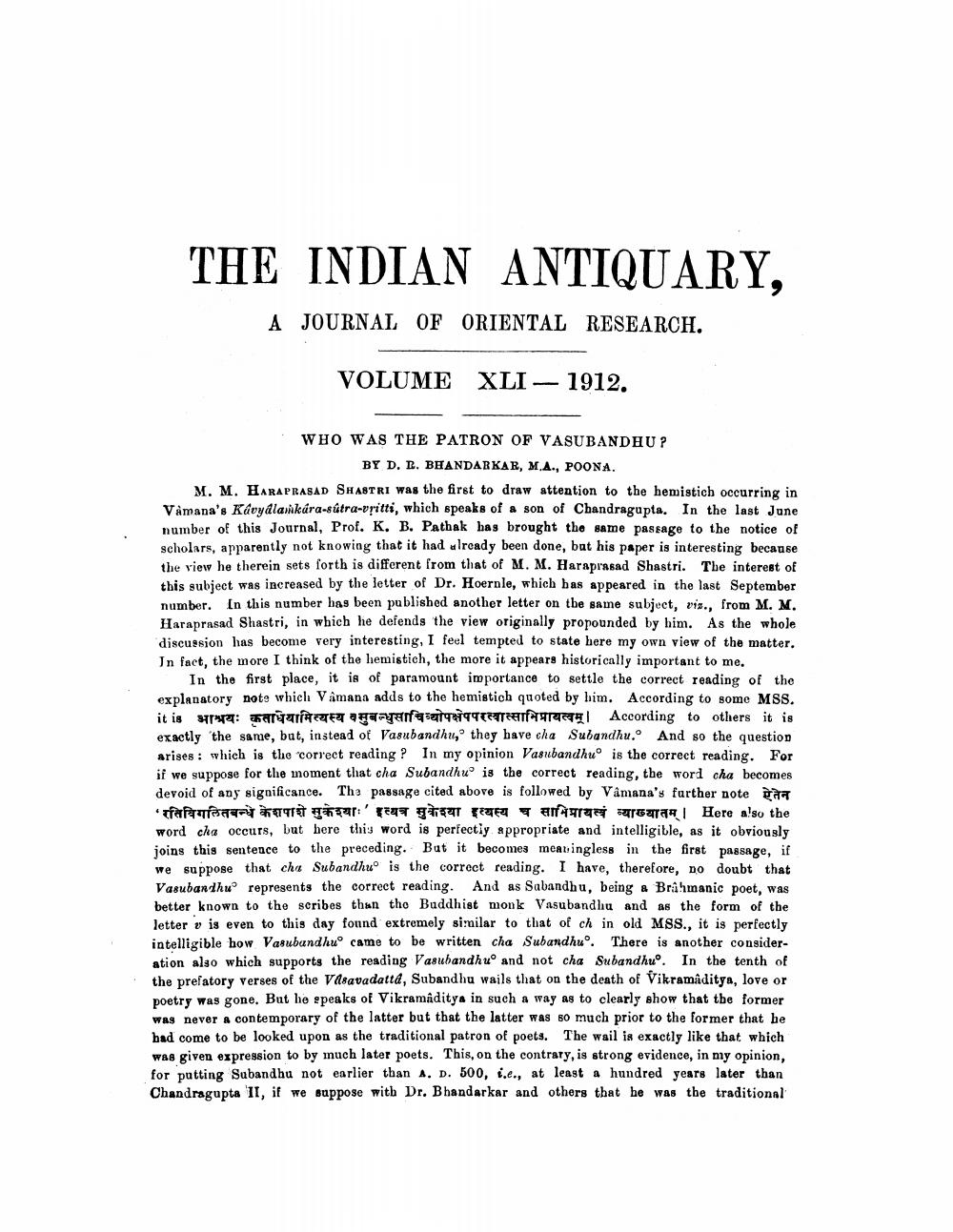Book Title: Indian Antiquary Vol 41 Author(s): Richard Carnac Temple, Devadatta Ramkrishna Bhandarkar Publisher: Swati Publications View full book textPage 5
________________ THE INDIAN ANTIQUARY, A JOURNAL OF ORIENTAL RESEARCH. VOLUME XLI - 1912. WHO WAS THE PATRON OF VASUBANDHU ? BY D. L. BHANDARKAR, M.A., POONA. M. M. HARAPRASAD SHASTRI was the first to draw attention to the hemistich occurring in Våmana's Kávydlasikára-sútra-vritti, which speaks of a son of Chandragupta. In the last June number of this Journal, Prof. K. B. Pathak has brought the same passage to the notice of scholars, apparently not knowing that it had already been done, but his paper is interesting because the view he therein sets forth is different from that of M. M. Haraprasad Shastri. The interest of this subject was increased by the letter of Dr. Hoernle, which has appeared in the last September number. In this number has been published another letter on the same subject, viz., from M. M. Haraprasad Shastri, in which he defends the view originally propounded by him. As the whole discussion has become very interesting, I feel tempted to state here my own view of the matter. In fact, the more I think of the hemistich, the more it appears historically important to me. In the first place, it is of paramount importance to settle the correct reading of the explanatory note which Vamana adds to the hemistich quoted by him. According to some MSS. it is 2: CUTEZ arqz996TErel According to others it is exactly the same, bat, instead of Vasubandhu,' they have cha Subandhu.' And so the question arises : which is the correct reading? In my opinion Vasubandhuo is the correct reading. For if we suppose for the moment that cha Subandhu is the correct reading, the word cha becomes devoid of any significance. The passage cited above is followed by Vamana's further note that farrer ' a ITE FEZTE a tareas Here also the word cha occurs, but here this word is perfectly appropriate and intelligible, as it obviously joins this sentence to the preceding. But it becomes meaningless in the first passage, if We suppose that cha Subandhu is the correct reading. I have, therefore, no doubt that Vasubandhuo represents the correct reading. And as Sabandhu, being a Brahmanic poet, was better known to the scribes than the Buddhist monk Vasubandhu and as the form of the letter v is even to this day found extremely similar to that of ch in old MSS., it is perfectly intelligible how Vasubandhuo came to be written cha Subandhu'. There is another consideration also which supports the reading Vasubandhuo and not cha Subandhuo. In the tenth of the prefatory verses of the Vasavadattd, Subandhu wails that on the death of Vikramaditya, love or poetry was gone. But he speaks of Vikramaditya in such a way as to clearly show that the former was never a contemporary of the latter but that the latter was so much prior to the former that he had come to be looked upon as the traditional patron of poets. The wail is exactly like that which was given expression to by much later poets. This, on the contrary, is strong evidence, in my opinion, for putting Sabandhu not earlier than A. D. 500, i.e., at least a hundred years later than Chandragupta II, if we suppose with Dr. Bhandarkar and others that he was the traditionalPage Navigation
1 ... 3 4 5 6 7 8 9 10 11 12 13 14 15 16 17 18 19 20 21 22 23 24 25 26 27 28 29 30 31 32 33 34 35 36 37 38 39 40 41 42 43 44 45 46 47 48 49 50 51 52 ... 320
